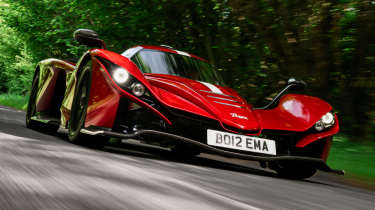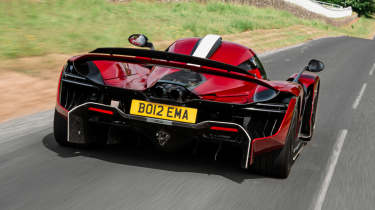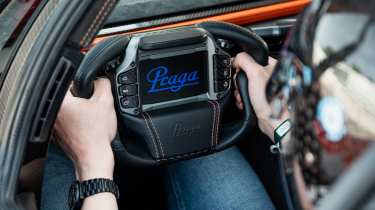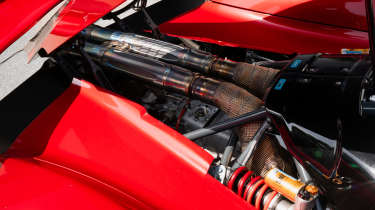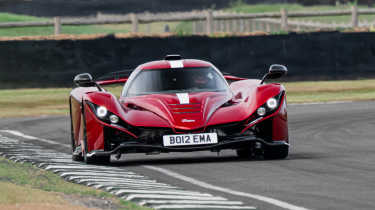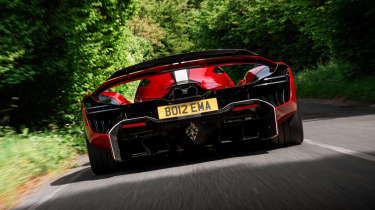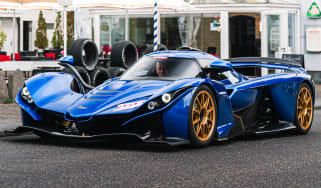Praga Bohema 2025 review – Nissan GT-R power in a half-price Aston Martin Valkyrie
Pairing 700bhp of Litchfield-prepared GT-R power with a near-1000kg weight figure, the Bohema is a £1.5million hypercar that’s aiming to shake up the establishment...
You join me in the Praga Bohema’s slimline cockpit, Goodwood Motor Circuit unfolding ahead through the visor-like windscreen. I’m on my second lap, building pace and tyre temperature gently, acclimatising to this extreme-looking creation. But something is troubling me…
You may recall Jethro Bovingdon drove the prototype Bohema on an airfield test track in evo issue 305 during the latter stages of the car’s development. Two and a half years on, production is underway and customer car deliveries likewise. Praga’s brought two Bohemas along to evo’s first Goodwood trackday of the year, so we can sample this high-downforce, low-volume hypercar in its finalised form. One is a customer car ready for handover, on static display to show off fit, finish and quality; the other is a hard-worked development car with more than 34,000 miles under its wheels but entirely representative of customer cars in technical spec and driving dynamics. And it’s in the latter Bohema that you join me.
Now, every kind of car is welcome at evo’s trackdays: old/new; fast/slow; exotic/everyday. It just so happens that in this particular session there are some quick cars circulating: 911 GT3s, Corvette C8s, a Ferrari, a McLaren. There’s never pressure to lap quickly at an evo day: so long as you’re making progress safely and giving each other space, it’s all about enjoying yourself at a pace that’s comfortable. But right now, everyone seems to be driving particularly slowly.
For a moment, I’m concerned I’ve missed a red flag and back off. Then it dawns on me. It’s not that the other cars are driving slowly. It’s just that the Praga is really bloody quick. This is not a car in the regular supercar realm; it’s from another place.
That will come as no surprise to anyone who’s been following the Bohema’s story so far. Praga is neatly described by UK CEO Mark Harrison as ‘the oldest car company nobody’s heard of’. During its near-120-year history, the Czech marque has designed and built cars, trains, buses, planes, motorcycles, karts, Dakar trucks… and highly successful racing cars, including the tiny, jewel-like R1. A limited-run road-legal R1R version was created in 2015 and was outrageously capable on track but an extreme proposition on the road.
The Bohema is a more evolved concept. It’s certainly still extreme, and still devised with track use in mind more than regular road driving, but it has a larger footprint, a larger performance envelope and positioning that’s less track-car curio, more high-end hypercar. In fact, the car the Bohema reminds me of most is the Aston Martin Valkyrie. The Valkyrie, with its active suspension and active aero, is a higher-tech creation, and neither car was designed to be a competitor with the other, so a direct comparison isn’t totally apt. But there are similarities in ethos between the two machines.
The Bohema’s ornate, organic-looking layers of carbon bodywork are designed for downforce; they develop 950kg of negative lift at 155mph. Meanwhile its carbonfibre monocoque chassis places you and a passenger inside a tiny, teardrop-shaped cockpit, your feet higher than your hips to better work the airflow over the front wing surfaces. It’s very narrow in there but somehow there’s space for two (the trick, chief engineer Jan Martínek explains, is where you position the occupants’ elbows).
Suspension is passive but fully adjustable, with inboard, pushrod-operated Ohlins dampers. Power comes from the 3.8-litre twin-turbo V6 originally designed for the Nissan GT-R – the first time Nissan has sanctioned the engine’s use by an external car company. Its power is increased to 700bhp via UK-based GT-R specialists Litchfield, who also convert it to a dry-sump set-up.
A production run of no more than 89 Bohemas will be built over five years. Like the Valkyrie, it has a seven-figure price: the Praga costs 1.43 million euros, plus taxes. That’s a lot for a car from a company many people haven’t heard of, powered by an engine some may feel is not exotic enough for a near £1.5m hypercar. The quality of the details and finish on the customer car goes at least some way toward endorsing that price.
Every visible component looks simultaneously functional and ornamental: sculptural hinges and brackets, contoured exhausts, intricate aero surfaces. Likewise, the interior is concept-car dramatic with lovely details and cleverly located controls and switchgear. There’s luggage provision, too, via carbonfibre storage boxes within deep, lockable sidepods. You could fit an overnight bag and/or crash helmet within them, for example.
Climbing in is a leg-stretch, tricep-dip manoeuvre, aided by removing the carbonfibre oblong steering wheel. The design is Praga’s own, and somewhat unique: its grips are shaped to fit the contours of your palms. It certainly feels like no other steering wheel I’ve held, and contributes to the sense of small-inputs precision on track.
You sit in a highly reclined driving position with the seat mouldings cradling not only your torso but the underside of your thighs too. The gearbox is a six-speed motorsport-style sequential paddleshift, by Hewland. Foot on the brake, click the right-hand paddle for first and then simply tickle the throttle to pull away – the clutch system is automatic.
Despite breathing through a titanium exhaust system, subjectively I wouldn’t say the V6 emits the most evocative of engine notes, but it has a lovely linear power delivery on track. The combination of low weight (just over a ton) and big power makes the Praga stunningly fast in a straight line – it’s easily approaching 170mph at the end of Goodwood’s back straight – but it’s a car designed for corners, not straight lines. And it’s not the way the Bohema goes that blows your mind. It’s the way it stops.
Deceleration is a game of dare that involves hitting the brake pedal as late as you can force yourself to, only to realise you can brake much later next lap. And the lap after that. And after that. The carbon-ceramic discs with six-piston calipers all-round wipe off speed tirelessly, and the downforce keeps the Bohema ultra-stable, no matter how hard you mash the left pedal. There is switchable ABS, but to get it to intervene you’ll need to be braking very hard indeed. Likewise there are multiple modes for the engine and traction control maps. Even in Road mode, this is a rapid car.
> McLaren 750S and Porsche 911 GT3 RS v hardcore track weapons – can the road racers compete?
I’ve driven one Praga before: the R1 race car in a brief test at Silverstone. It was a tiny, buzzy car, pretty in a Piranha-like kind of way, with a similarly sharp-toothed Formula Renault engine bolted to the tub. It was an exhilarating, ultra-agile car capable of lap times far quicker than GT3 racing cars.
The Bohema feels more grown-up, less intense, more rounded. The most similar machine in character I’ve driven on track is an LMP3 car: there’s the same sense of glued-down stability, and an endless well of engine muscle to draw from. Goodwood is a fast enough place to feel the aero surfaces painting the Bohema into the road.
This both gives you confidence and a sense of trepidation in approaching the Bohema’s handling limits, given that they’re so high. But when you do, its balance is approachable. It’s safe, stable; unruffled, even. But still engaging and rewarding. You sense the trick to getting a lap time would be managing the split-second point between the end of braking and the entry phase of a given corner, and that’s where a really good driver would make the difference – much like in a racing car. But the Bohema is not edgy like a race car. It might look angry but its driving manners are anything but – even as tested here on well-used Michelin Cup 2 Rs and in a baseline set-up.
And on the road? It’s a more challenging experience. We head out of the gates for an exploratory tour of the lanes around Goodwood, and the Bohema is enormous fun – but largely from the sense of is-this-really-legal outlawishness that comes from driving such an extreme creation on normal roads.
> Aston Martin Valkyrie 2025 review – 700 miles in the world's most extreme hypercar
Unlike the Aston Martin Valkyrie and the Praga R1R, the engine is not a stressed member solidly mounted to the monocoque but instead is rubber-mounted to a subframe, which significantly reduces the vibrations that would otherwise course through the cockpit – and the noise. Unlike with the Valkyrie, you don’t need to wear noise-cancelling headphones to drive the Bohema. But then again, it’s not exactly a limo.
The gearbox takes a little learning: although it’s a paddleshift with an automatic clutch, you need to time the shifts carefully to avoid an uncomfortable lashing sensation from first to second gear (the Valkyrie, for example, is easier since it adopts a hybrid powertrain with an electric motor to smooth shifts and handle drive at urban speeds). It feels even tighter inside than the Valkyrie, particularly in terms of elbow room, and I need to adjust the steering wheel a few times to find a totally comfortable position. Likewise, I find the wheel’s unusual grips more comfortable on the track than on the road, where you need larger inputs of lock.
You can see the front wheels through openings in the bodywork, which is handy for placing the car in traffic and on narrow roads and streets. The Bohema is about 2m wide, and roughly 30mm narrower than a Pagani Utopia. Despite its low ride height, it’s able to negotiate speedbumps.
The mirrors, mounted on blade-like carbonfibre spars, give an excellent view behind. The tricky thing – as per the Valkyrie and other mid-engined, multi-point-harness cars, such as Radical’s RXC coupe – is being able to turn your head easily enough at T-junctions for a clear view through the small side windows. The trick is to slacken your belts as you approach and line the car up as straight as you can to maximise your view either side. For three-point turns you may need to take off the belts altogether to see past the sizeable blind-spots. Like many motorsport-esque cars, the turning circle is relatively large; closer to that of a van than a car.
So the Praga is a more convincing car on track than on road. A verdict you probably saw coming two years ago. As a result, it’s easy to dismiss this kind of car as an irrelevance, a niche within a niche. But the Bohema is a truly compelling machine. It’s artfully engineered, beautifully finished (though so it should be, given the price) and possesses truly remarkable abilities on track. This has been a slightly-too-brief snapshot of the Bohema’s talents but an impressive one. Not every car I’ve driven on a track has left me craving another go, remembering the experience weeks later. But the Praga is not every car.
Praga Bohema specs
| Engine | V6, 3799cc, twin-turbo |
| Weight | 1070kg (685bhp/ton) |
| Power | 700bhp @ 6900rpm |
| Torque | 575lb ft @ 5000-6000rpm |
| Transmission | Six-speed sequential |
| Top speed | 193mph |
| 0-62mph | 3.3sec |
